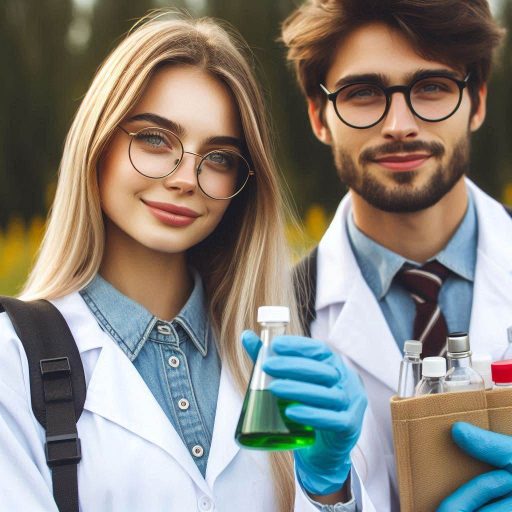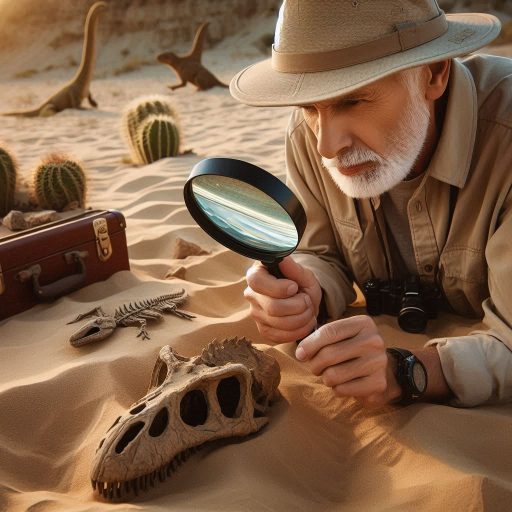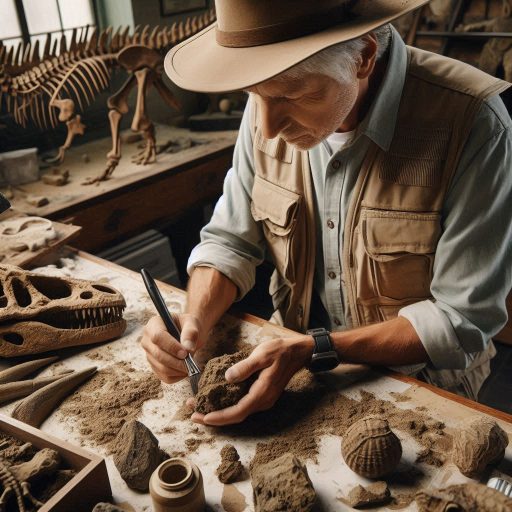Introduction
Traveling for fieldwork is an essential part of paleontology, as it allows scientists to uncover fossils and study ancient life.
Each expedition provides a unique opportunity to explore diverse geological formations and discover valuable specimens that hold secrets to Earth‘s past.
The thrill of digging up fossils in remote locations fuels a deep passion for discovery among paleontologists and students alike.
Paleontology expeditions often take researchers to breathtaking landscapes, from arid deserts to lush riverbanks and rugged mountains.
These adventures foster a profound connection between scientists and the natural world, inspiring them to appreciate the beauty and complexity of Earth’s history.
The excitement of uncovering a fossil, whether it‘s a rare dinosaur bone or a delicate plant imprint, often leads to significant findings that enhance our understanding of ancient ecosystems.
Additionally, these trips build camaraderie among researchers, creating lasting friendships and collaborations that can span years.
The shared experiences of travel and discovery forge strong bonds, leading to teamwork and cooperation in research endeavors.
Young scientists gain invaluable hands-on experience while learning from seasoned professionals.
This mentorship nurtures a new generation of paleontologists, eager to carry on the legacy of exploration and discovery.
Choosing the Destination
Researching Potential Locations for Paleontology Fieldwork
Researching potential locations for paleontology fieldwork is essential for a successful expedition.
Paleontologists often rely on a mix of scientific literature, online resources, and field guides.
These sources help identify promising sites rich in fossils.
Early research allows paleontologists to understand the geological context of potential sites.
Accessibility is a crucial factor when choosing a fieldwork location.
Researchers must consider the terrain, distance from urban centers, and local infrastructure.
Remote locations can pose challenges for transportation and logistics.
Ensuring a site is reachable enhances the efficiency of the expedition.
Permits also play a significant role in the planning process.
Many locations require specific permissions to conduct fossil excavations.
Paleontologists must familiarize themselves with local regulations and guidelines.
Obtaining the necessary permits in advance prevents legal complications during the fieldwork.
This step is vital for maintaining ethical and responsible excavation practices.
Additionally, researchers should consider the history of fossil discoveries in the area.
Sites with a rich fossil record often attract paleontologists due to their potential for new finds.
Understanding previous discoveries can guide researchers in formulating hypotheses for their studies.
Knowledge of what fossils have been found can also help identify which methods might be most effective for excavation.
Considering Factors Such as Accessibility, Permits, and Previous Fossil Discoveries
When planning an expedition, accessibility, permits, and previous discoveries are critical factors.
Accessibility impacts both the planning and execution of fieldwork.
Choosing a site that is easy to reach can save time and resources.
It ensures that researchers can focus on their primary goal: uncovering fossils.
Permits are not just a bureaucratic hurdle; they ensure the protection of valuable sites.
They also demonstrate a commitment to ethical research practices.
Navigating the permitting process can be time-consuming, so planning ahead is crucial.
Knowledge of past fossil discoveries informs researchers about the site‘s potential.
Paleontologists can use this information to enhance their excavation strategies.
They can also target specific geological layers that have yielded fossils before.
This strategic approach increases the likelihood of significant finds during the expedition.
Highlighting Popular Destinations for Paleontology Expeditions
Several popular destinations attract paleontologists from around the world.
The Badlands of South Dakota is renowned for its rich fossil deposits.
This area offers a diverse range of prehistoric fauna, including dinosaurs and ancient mammals.
The exposed rock formations make it an ideal location for fieldwork.
Another exciting destination is the La Brea Tar Pits in California.
This site preserves fossils of Ice Age animals, such as saber-toothed cats and mammoths.
The unique tar deposits provide excellent preservation conditions.
Additionally, the Burgess Shale in Canada offers a glimpse into early marine ecosystems.
This UNESCO World Heritage site is famous for its exceptional preservation of soft-bodied organisms.
Paleontologists flock to this location to study the Cambrian Explosion’s biodiversity.
Basically, researching potential locations for paleontology fieldwork is a crucial first step.
Considering factors like accessibility, permits, and previous discoveries enhances the expedition’s success.
Popular destinations, such as the Badlands and La Brea Tar Pits, provide unique opportunities for significant findings.
Each expedition offers a chance to contribute to our understanding of Earth’s history and its ancient inhabitants.
Preparing for the Expedition
Packing Essentials Such as Tools, Safety Gear, and Camping Equipment
Packing for a paleontology fieldwork expedition requires careful consideration of essential items.
Start by gathering necessary tools for fossil excavation.
A trowel, brush, and pick are fundamental for careful digging.
Paleontologists also need containers for transporting fossils, such as buckets or padded boxes.
Safety gear is crucial when working in remote areas.
A sturdy pair of hiking boots protects your feet while exploring rough terrain.
A hard hat can safeguard against falling rocks during excavation.
Always bring gloves to protect your hands from sharp edges and rough surfaces.
Camping equipment is another essential part of your packing list.
Choose a reliable tent that can withstand various weather conditions.
A quality sleeping bag keeps you warm during chilly nights.
Additionally, pack a portable stove or cooking equipment for meal preparation.
Don‘t forget water purification systems to ensure access to clean drinking water in the field.
Making Travel Arrangements and Booking Accommodations
Making travel arrangements is another key aspect of preparing for a paleontology expedition.
Start by planning your route to the field site.
Research the best transportation options, whether by car, plane, or public transport.
Book tickets well in advance to secure the best rates and availability.
Next, consider accommodations.
Many expeditions involve remote locations where camping is necessary.
If you prefer more comfort, look for nearby hotels or lodges.
Reserve your accommodations early, especially during peak travel seasons.
Communicate with your team to ensure everyone has a place to stay.
If your expedition requires travel to multiple locations, consider vehicle rentals.
Ensure the vehicle is suitable for rugged terrain.
Verify that it has enough space for all team members and their equipment.
Plan your itinerary carefully to maximize time spent in the field and minimize travel time.
Discussing the Physical Fitness Required for Fieldwork
Physical fitness is crucial for success in paleontology fieldwork.
Excavation can be physically demanding, often requiring long hours of walking, bending, and lifting.
Maintaining a good fitness level helps prevent injuries during these strenuous activities.
Engaging in regular exercise routines prepares you for the challenges ahead.
Activities like hiking, jogging, or weight training can enhance your strength and stamina.
Focus on core and leg workouts to build the necessary endurance for long days in the field.
Flexibility is also important, as you may need to navigate uneven terrain.
Stretching exercises can improve flexibility and reduce the risk of muscle strain.
Incorporate yoga or Pilates into your routine for additional benefits.
Lastly, stay hydrated and nourished while working in the field.
Carry enough water and healthy snacks to sustain energy levels throughout the day.
This preparation ensures you can focus on your research rather than fatigue or dehydration.
Therefore, preparing for paleontology fieldwork involves careful packing, travel arrangements, and physical readiness.
By ensuring you have the right tools, accommodations, and fitness levels, you enhance your chances for a successful and enjoyable expedition.
Happy fossil hunting!
Read: Essential Skills and Tools for Modern Chemists in America
Daily Routine on the Expedition
Waking Up Early to Start the Day’s Fieldwork
Fieldwork in paleontology begins early.
Researchers wake up before sunrise to maximize daylight hours.
The excitement of a new day fuels their energy.
Early mornings provide a quiet time to prepare for excavation.
Paleontologists review their plans and gather necessary equipment.
A hearty breakfast is essential to sustain energy levels.
Team members share their expectations and enthusiasm for the day ahead.
As the sun rises, everyone gears up for an exciting adventure.
The morning air feels fresh, invigorating the team.
They travel to the excavation site, often on rough terrain.
The journey can be bumpy, but the excitement keeps spirits high.
Upon arrival, the team surveys the area, eager to discover new fossils.
They set up their equipment, including tools for excavation and documentation.
The thrill of uncovering ancient life drives their motivation.
Engaging in Excavation, Fossil Collecting, and Documentation
Once ready, the team starts the excavation process.
Each member has a specific role, from digging to documenting findings.
Using tools like brushes and trowels, they carefully remove soil and rock.
This meticulous process helps preserve delicate fossils.
Paleontologists take great care to avoid damaging important specimens.
As they uncover fossils, the excitement builds.
Each discovery could offer new insights into prehistoric life.
Team members photograph and sketch their findings.
Detailed documentation is crucial for later analysis.
They note the fossil’s location, orientation, and surrounding materials.
This information helps contextualize the fossils in future research.
In addition to fossils, the team collects geological samples.
These samples provide valuable data about the environment during the fossil’s existence.
By analyzing the sediment, paleontologists can reconstruct ancient ecosystems.
This multi-faceted approach enhances their understanding of life’s history on Earth.
Taking Breaks for Meals and Hydration
After hours of hard work, the team takes breaks for meals.
Eating lunch together fosters camaraderie among team members.
They share stories about their discoveries and experiences.
Good food helps recharge their energy for the afternoon.
Hydration is also essential in the field.
Team members regularly sip water to stay refreshed and focused.
During breaks, they enjoy the beauty of their surroundings.
The landscapes can be breathtaking, providing moments of inspiration.
Team members take time to relax and appreciate nature.
This downtime rejuvenates their spirits, preparing them for the next excavation session.
As the day winds down, they review their findings.
Reflecting on the day‘s work solidifies the experience.
Each expedition contributes to their understanding of paleontology.
The thrill of discovery and the joy of teamwork make fieldwork unforgettable.
In review, traveling for paleontological fieldwork is an exciting adventure.
Waking up early, engaging in excavation, and taking breaks are all vital parts of the experience.
Each day brings new challenges and discoveries, deepening their passion for uncovering Earth’s history.
Through teamwork and dedication, paleontologists contribute to our understanding of ancient life.
Read: The Role of Chemists in US Environmental and Sustainability Efforts
Dealing with Challenges
Potential Challenges Such as Extreme Weather Conditions, Difficult Terrain, and Wildlife Encounters
Traveling for paleontology fieldwork offers thrilling adventures, but challenges often arise.
Extreme weather conditions can hinder expeditions and affect safety.
Researchers may face scorching heat, heavy rains, or freezing temperatures, each presenting unique risks.
Difficult terrain poses additional challenges, including rocky landscapes, steep hills, and dense forests.
Navigating such environments can be physically demanding and may require specialized skills.
Wildlife encounters add another layer of complexity to fieldwork.
While many animals pose little threat, some can be dangerous.
Snakes, bears, and large mammals may inhabit excavation sites, creating potential hazards for researchers.
Understanding these risks is crucial for ensuring the safety of all team members.
Strategies for Overcoming Obstacles and Staying Safe During Fieldwork
To tackle these challenges, paleontologists should prepare thoroughly before expeditions.
Comprehensive planning is essential for addressing weather-related concerns.
Researchers should monitor forecasts and adapt their schedules accordingly.
Packing appropriate clothing and gear helps mitigate risks associated with extreme temperatures and precipitation.
When facing difficult terrain, proper training is vital.
Team members should practice hiking and climbing techniques before fieldwork begins.
Using appropriate equipment, like sturdy footwear and hiking poles, enhances safety on rugged paths.
Additionally, carrying emergency supplies ensures preparedness for unforeseen circumstances, such as injuries or sudden weather changes.
Wildlife encounters require specific strategies for prevention and management.
Researchers should familiarize themselves with local fauna before their trip.
Understanding animal behavior helps in avoiding encounters and reacting appropriately if they occur.
For instance, making noise while hiking can deter certain wildlife from approaching.
Communication is critical for ensuring safety during fieldwork.
Establishing clear channels for reporting issues or emergencies can save lives.
Teams should conduct daily briefings to discuss plans and potential hazards.
Using two-way radios or mobile phones can facilitate quick communication in remote areas.
The Importance of Teamwork and Communication
Effective teamwork and communication are essential for overcoming challenges during paleontological expeditions.
Team members must rely on each other for support and problem-solving.
Collaborating on tasks such as setting up camps, transporting equipment, or excavating fossils enhances efficiency and morale.
Fostering a positive team environment encourages open dialogue.
Team members should feel comfortable sharing concerns or suggestions.
This openness can lead to innovative solutions for overcoming obstacles.
Regular check-ins during the expedition help maintain awareness of each other’s well-being.
In general, paleontology fieldwork presents exciting opportunities but also comes with challenges.
Extreme weather, difficult terrain, and wildlife encounters can pose risks.
Researchers must develop strategies to mitigate these hazards, focusing on thorough preparation and effective communication.
Teamwork plays a vital role in ensuring the safety and success of field expeditions.
By fostering collaboration and maintaining open lines of communication, paleontologists can navigate challenges and enjoy their adventures in the field.
Read: Day in the Life: An Environmental Scientist‘s Typical Day

Exciting Discoveries
Sharing Stories of Unexpected Fossil Finds and Breakthroughs
Traveling for fieldwork often leads to unexpected fossil finds and breakthroughs.
Paleontologists embark on expeditions with excitement and anticipation.
Sometimes, they discover fossils in the most unlikely places.
For instance, a team might stumble upon a well-preserved dinosaur bone in a remote area.
Such discoveries can redefine our understanding of ancient ecosystems.
One paleontologist recalls finding a perfectly preserved ammonite fossil while digging in a riverbed.
This unexpected find contributed to the knowledge of marine life during the Jurassic period.
It also highlighted the significance of thorough exploration and observation.
Such stories inspire aspiring paleontologists and emphasize the value of fieldwork.
Describing the Thrill of Uncovering and Identifying Fossils in the Field
The thrill of uncovering and identifying fossils in the field is unparalleled.
Every dig site holds the potential for new discoveries.
When a paleontologist brushes away dirt to reveal a fossil, adrenaline rushes through them.
This moment of discovery connects them to ancient life forms that roamed the Earth millions of years ago.
Identifying fossils is equally exciting.
Paleontologists must use their knowledge and skills to determine species and age.
They often collaborate with colleagues, sharing insights and perspectives.
This collaboration fosters a sense of community and shared purpose.
Every new identification adds a piece to the puzzle of Earth’s history.
Fieldwork also offers the chance to witness the beauty of nature.
While searching for fossils, paleontologists often explore stunning landscapes.
The combination of adventure, science, and exploration creates unforgettable experiences.
These moments are not only thrilling but also deeply rewarding.
The Significance of Discoveries for Paleontology Research
Discoveries made during fieldwork have significant implications for paleontology research.
Each fossil found contributes to our understanding of evolutionary history.
Fossils can provide insights into how species adapted to changing environments.
They can also reveal patterns of extinction and survival over time.
For example, a new dinosaur species can change previous assumptions about its relatives.
Such findings often lead to reevaluations of phylogenetic trees.
This process enriches our understanding of biodiversity and evolution.
Moreover, discoveries can inform scientists about ancient climate conditions and ecosystems.
Fieldwork also fosters collaboration among scientists.
When new fossils are uncovered, researchers often share findings with museums and universities.
This sharing enhances knowledge and encourages further investigation.
Additionally, discoveries can engage the public‘s interest in paleontology.
Exhibits featuring new fossils draw attention and spark curiosity about ancient life.
In essence, traveling for fieldwork opens doors to exciting paleontology expeditions.
Sharing stories of unexpected finds and breakthroughs enhances the field’s narrative.
The thrill of uncovering and identifying fossils creates lasting memories.
Each discovery significantly contributes to paleontology research and our understanding of Earth‘s history.
Fieldwork embodies the adventure of science, connecting past and present in meaningful ways.
Read: The Impact of Technology on the Chemist Profession in the US
Transform Your Career Today
Unlock a personalized career strategy that drives real results. Get tailored advice and a roadmap designed just for you.
Start NowBuilding Relationships
Connecting with Fellow Paleontologists, Researchers, and Local Communities
Traveling for fieldwork provides invaluable opportunities to connect with fellow paleontologists and researchers.
Engaging with professionals in the field fosters a sense of community and collaboration.
These connections enhance the overall experience and contribute to personal and professional growth.
Fieldwork expeditions often involve teamwork, where paleontologists from various backgrounds work side by side.
Collaborating with local researchers can provide unique insights into the area’s geological features.
Local communities often possess valuable knowledge about the land, helping paleontologists identify significant fossil sites.
Building relationships with local residents can create a supportive network that benefits both the research and the community.
Participating in fieldwork also encourages the exchange of ideas and techniques.
By discussing methodologies, researchers can improve their practices and develop innovative approaches.
Learning from one another fosters an environment of growth and exploration, essential for advancing the field of paleontology.
Collaborating on Projects and Sharing Knowledge and Expertise
Fieldwork expeditions often lead to collaborative projects among scientists from different institutions.
This collaboration allows researchers to pool resources, equipment, and expertise for more impactful results.
Working together on joint projects can enhance the scope and significance of findings.
Sharing knowledge is crucial in paleontology, as discoveries often lead to new questions and areas of research.
When researchers collaborate, they can combine their unique skills and perspectives to tackle complex challenges.
This approach promotes interdisciplinary research, leading to a deeper understanding of ancient ecosystems and the organisms that inhabited them.
Fieldwork allows for hands-on experience and learning opportunities that deepen knowledge in paleontological methods.
Researchers often conduct field training for students and early-career professionals during expeditions.
This mentorship cultivates the next generation of paleontologists and strengthens the scientific community.
Networking Opportunities and Building Professional Relationships
Traveling for fieldwork also opens doors to valuable networking opportunities.
Conferences and workshops often coincide with fieldwork expeditions, allowing scientists to meet and interact.
These events provide platforms for presenting research, discussing ideas, and seeking feedback from peers.
Networking is crucial for career advancement in paleontology.
Building professional relationships can lead to collaborations on future projects or job opportunities.
Many successful paleontologists attribute their career growth to the connections made during fieldwork and conferences.
Moreover, maintaining these relationships is essential for long-term success.
Following up with contacts after expeditions can lead to future collaborations and friendships.
Engaging in social media and professional networks also helps sustain connections made during fieldwork.
Generally, traveling for fieldwork in paleontology offers exciting opportunities to connect with fellow researchers and local communities.
Collaborating on projects fosters knowledge exchange and strengthens the scientific community.
Additionally, networking during expeditions helps build valuable professional relationships that contribute to individual and collective success in paleontology.
Embrace the adventure of fieldwork, and open the door to new connections and discoveries.
Documenting and Preserving Fossils
Explaining the Importance of Documenting Fieldwork Findings and Preserving Fossils
Fieldwork is a critical aspect of paleontology.
Documenting findings accurately ensures researchers preserve important data for future study.
Each fossil discovered provides insights into ancient ecosystems and life forms.
By recording details like location, stratigraphy, and context, scientists create a comprehensive picture of past environments.
Preserving fossils is equally vital.
Fossils can deteriorate quickly if not properly cared for.
Researchers must use appropriate techniques for cleaning, storing, and displaying these valuable specimens.
Proper preservation techniques help maintain the integrity of the fossils for future research.
Additionally, well-preserved fossils can educate the public and inspire future generations of scientists.
Using Technology Such as Photography and 3D Scanning to Record Discoveries
Technology has revolutionized how paleontologists document their findings.
High-quality photography allows researchers to capture detailed images of fossils in situ.
These photographs serve as visual records that complement written documentation.
They can illustrate the fossil‘s position within the surrounding rock and provide context for its discovery.
3D scanning technology has also become essential in modern paleontology.
Researchers use 3D scanners to create detailed digital models of fossils.
These models can be shared with other scientists, enhancing collaboration and study.
They allow for virtual examinations without risking damage to the original specimen.
Furthermore, 3D models can be used for educational purposes, helping to engage the public in paleontological discoveries.
This technology also allows for advanced analysis of fossils.
Scientists can study morphological changes and conduct comparisons without physically handling delicate specimens.
This capability enhances research efficiency and expands accessibility to fossil collections worldwide.
Discussing Ethical Considerations and Regulations for Handling Fossils
Ethical considerations are paramount in paleontological fieldwork.
Researchers must respect the land and its cultural significance while conducting excavations.
They should obtain necessary permits and permissions before starting their work.
This practice ensures they adhere to local regulations and respect the rights of landowners and indigenous peoples.
Proper handling of fossils also raises ethical concerns.
Paleontologists must avoid removing fossils from their context without justification.
This practice is crucial to maintain the scientific value of the fossil and its surroundings.
Responsible excavation methods help prevent irreversible damage to the fossil and its geological context.
Additionally, researchers should consider the implications of fossil sales and ownership.
Fossils are often considered national heritage and should remain accessible for public education and scientific research.
Paleontologists must advocate for ethical practices in fossil collection and trade.
This advocacy ensures that fossils benefit future generations rather than becoming mere commodities.
Essentially, documenting fieldwork findings and preserving fossils is essential for paleontological research.
Technology, such as photography and 3D scanning, enhances the accuracy of these records.
Ethical considerations and regulations guide how researchers handle fossils responsibly.
By following these practices, paleontologists contribute to a richer understanding of our planet’s history while promoting sustainable and ethical practices in the field.
Gain More Insights: Salary Expectations for Climatologists in the USA
Conclusion
Traveling for fieldwork in paleontology is an exhilarating journey that offers a unique blend of excitement and adventure.
The thrill of uncovering ancient fossils in remote locations creates an unforgettable experience for paleontologists.
These expeditions leave a lasting impact on the careers and research of paleontologists.
Fieldwork experiences provide hands-on opportunities to study fossils in their natural habitat, deepening scientific knowledge and understanding of ancient life forms.
For anyone interested in paleontology, traveling for fieldwork is a transformative experience that can shape their future research and discoveries.
The invaluable lessons learned during these expeditions not only enrich knowledge but also inspire new ideas and perspectives, pushing the boundaries of scientific exploration.
As we reflect on the excitement and adventure of paleontology expeditions, it’s clear that traveling for fieldwork is more than just a job‘it’s a passion-filled pursuit that fuels curiosity, discovery, and innovation.
By encouraging readers to consider embarking on their own fieldwork adventures, we hope to inspire a new generation of paleontologists to explore the wonders of the prehistoric world and make groundbreaking discoveries that shape our understanding of life on Earth.
[E-Books for Sale]
The Big Book of 500 High-Paying Jobs in America: Unlock Your Earning Potential
$19.99 • 500 High-Paying Jobs • 330 pages
Explore 500 high-paying jobs in America and learn how to boost your career, earn more, and achieve success!
See All 500 High-Paying Jobs of this E-Book
1001 Professions Without a Degree: High-Paying American Jobs You Can Start Now
$19.99 • 1001 Professions Without a Degree • 174 pages
Discover 1001 high-paying jobs without a degree! Unlock career tips, skills, and success strategies for just $19.99!




